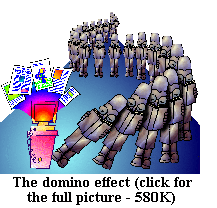E-print Archives: Key to Paperless Journals
Electronic journals could overturn the dominant force of print in a scenario created by a 'domino effect'. At a conference on scholarly publication held recently at the University of Stirling, Stevan Harnad, Professor of Psychology at Southampton University and editor of the well-respected print journal Behavioral and Brain Sciences and the online journal Psycoloquy, described how a rapid switch away from paper journals could occur.
The catalyst will be the creation of electronic preprint archives in the main academic disciplines. Harnad referred to the Los Alamos National Laboratory Electronic Preprint Archive for physics literature, started by Paul Ginsparg in 1991. This archive is now used globally by researchers in most of the areas of physics, and is estimated to have captured over 70% of the current physics journal literature.
No serious attempt  has yet been made to emulate its success in other disciplines. The Los Alamos archive has succeeded in dispersing the stereotype which sees the network as a 'second-best' publishing medium. Most authors in physics now routinely substitute their Los Alamos preprints with electronic versions of the final, refereed, published versions of their articles.
has yet been made to emulate its success in other disciplines. The Los Alamos archive has succeeded in dispersing the stereotype which sees the network as a 'second-best' publishing medium. Most authors in physics now routinely substitute their Los Alamos preprints with electronic versions of the final, refereed, published versions of their articles.
But the result, says Harnad, is an economic absurdity. "Print journal publishers continue to make profits by pushing up their prices and relying on their academic library customers. The journals fill the shelves of libraries and lie unused, since everyone is already reading the articles online." Absurd though it is, this system somehow manages to stagger on. "But libraries will get wise to this" warns Harnad. "They won't be content to bankroll the expensive and inefficient paper journal process forever."
The 'domino effect' will be the change in usage patterns from paper to electronic.  "It starts with the preprints" says Harnard. "This leads to readers going there first, which leads to swapping for reprints: this keeps the readers in the archive. Then, as there is no use for the paper version any more, library subscription revenues fall, and publishers either switch to electronic only, recovering costs from author page charges, or else they release their journals - whose editorial boards will simply reconstitute electronically under the same name, with learned society sponsorship."
"It starts with the preprints" says Harnard. "This leads to readers going there first, which leads to swapping for reprints: this keeps the readers in the archive. Then, as there is no use for the paper version any more, library subscription revenues fall, and publishers either switch to electronic only, recovering costs from author page charges, or else they release their journals - whose editorial boards will simply reconstitute electronically under the same name, with learned society sponsorship."
But this does not mean that publishers themselves will disappear. The peer review and copy editing role which publishers have in the dissemination of scholarly literature is still essential, but will need to be funded from a source other than subscriptions to printed journals.
Page charges are Harnad's answer. Authors themselves will pay to have their work published in online journals (using research or institutional funding). Harnard maintains that ten dollars per page would be sufficient to finance the operation. "The match-box calculations have all been done".
The switch is needed now. "It's time for the dominoes to fall" stated Harnard. If they do, then, for librarians, the days of trying to divide meagre journal budgets among academic departments hungry for ever greater numbers of academic journal titles, may soon be coming to an end.
